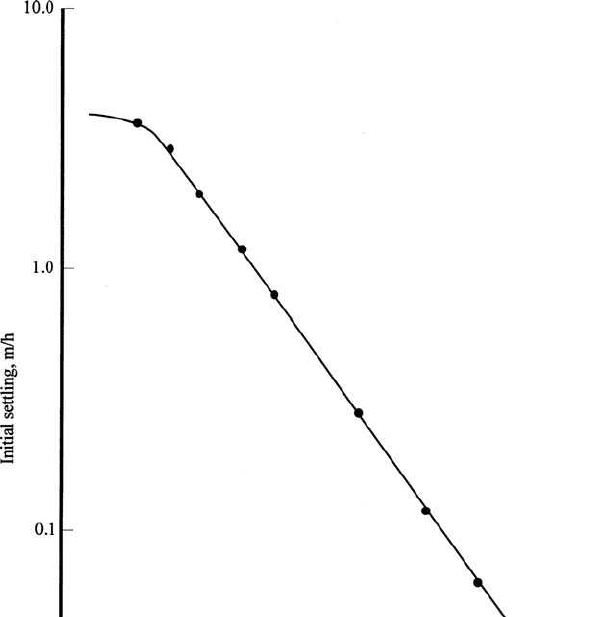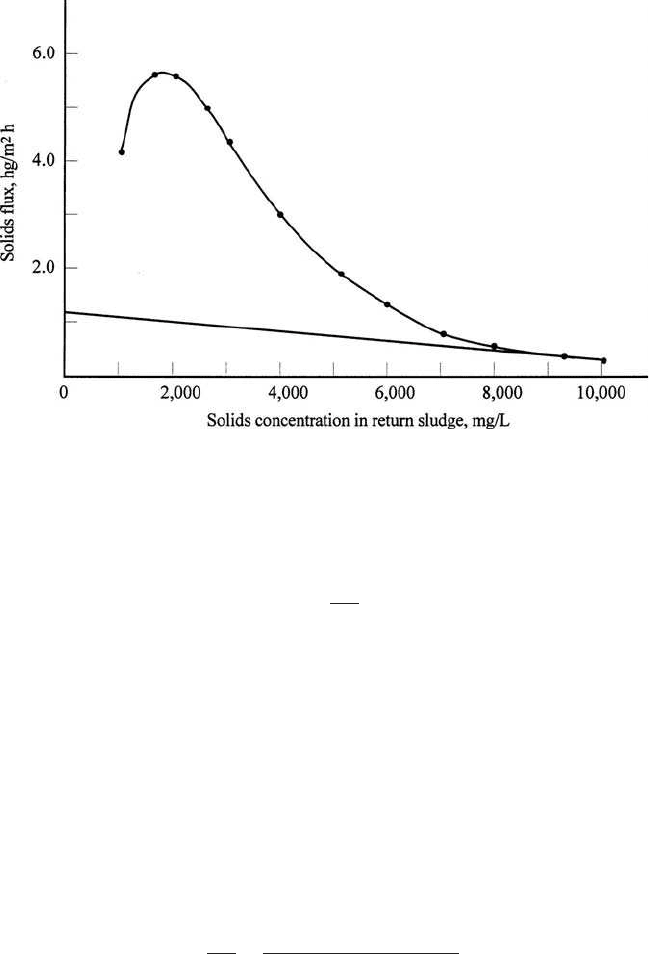Lin S.D. Water and Wastewater Calculations Manual
Подождите немного. Документ загружается.

Oxygen requirements generally depend on the design peak hourly
BOD
5
, MLSS, and degree of treatment. Aeration equipment must be able
to maintain a minimum of 2.0 mg/L of dissolved oxygen concentration
in the mixed liquor at all times and provide adequate mixing. The
normal air requirements for all activated-sludge systems, except
extended aeration, are 1.1 kg of oxygen (93.5 m
3
of air) per kg BOD
5
or
1.1 lb of oxygen (1500 ft
3
of air) per lb BOD
5
, for design peak aeration
tank loading. That is 94 m
3
of air per kg of BOD
5
(1500 ft
3
/lb BOD
5
) at
standard conditions of temperature, pressure, and humidity. For the
extended aeration process, normal air requirements are 128 m
3
/kg BOD
5
or 2050 ft
3
/lb BOD
5
(GLUMRB, 1996).
For F/M ratios greater than 0.3 d
⫺1
, the air requirements for con-
ventional activated-sludge systems amount to 31 to 56 m
3
/kg (500 to
900 ft
3
/lb) of BOD
5
removed for coarse bubble (nonporous) diffusers
and 25 to 37 m
3
/kg (400 to 600 ft
3
/lb) BOD
5
removal for fine bubble
(porous) diffusers. For lower F/M ratios, endogenous respiration, nitri-
fication, and prolonged aeration increase air use to 75 to 112 m
3
/kg
(1200 to 1800 ft
3
/lb) of BOD
5
removal. In practice, air requirements
range from 3.75 to 15.0 m
3
air/m
3
water (0.5 to 2 ft
3
/gal) with a typical
value of 7.5 m
3
/m
3
or 1.0 ft
3
/gal (Metcalf and Eddy, Inc. 1991).
Example 1a: Design a complete-mix activated-sludge system.
Given:
Average design flow ⫽ 0.32 m
3
/s (6.30 Mgal/d)
Peak design flow ⫽ 0.80 m
3
/s (18.25 Mgal/d)
Raw wastewater BOD
5
⫽ 240 mg/L
Raw wastewater TSS ⫽ 280 mg/L
Effluent BOD
5
ⱕ 20 mg/L
Effluent TSS ⱕ 24 mg/L
Wastewater temperature ⫽ 20⬚C
Operational parameters and biological kinetic coefficients:
Design mean cell residence time u
c
⫽ 10 d
MLVSS ⫽ 2400 mg/L (can be 3600 mg/L)
VSS/TSS ⫽ 0.8
TSS concentration in RAS ⫽ 9300 mg/L
Y ⫽ 0.5 mg VSS/mgBOD
5
k
d
⫽ 0.06/d
BOD
5
/ultimate BOD
u
⫽ 0.67
Wastewater Engineering 635

Assume:
1. BOD (i.e. BOD
5
) and TSS removal in the primary clarifiers are 33% and
67%, respectively.
2. Specific gravity of the primary sludge is 1.05 and the sludge has 4.4% of
solids content.
3. Oxygen consumption is 1.42 mg per mg of cell oxidized.
solution:
Step 1. Calculate BOD and TSS loading to the plant
Design flow Q ⫽ 0.32 m
3
/s ⫻ 86,400 s/d
⫽ 27,648 m
3
/d
Since 1 mg/L ⫽ 1 g/m
3
⫽ 0.001 kg/m
3
BOD loading ⫽ 0.24 kg/m
3
⫻ 27,648 m
3
/d
⫽ 6636 kg/d
TSS loading ⫽ 0.28 kg/m
3
⫻ 27,648 m
3
/d
⫽ 7741 kg/d
Step 2. Calculate characteristics of primary sludge
Step 3. Calculate flow, BOD, and TSS in primary effluent (secondary influent)
5
4446 kg/d 3 1000 g/kg
27,536 m
3
/d
5 4446 kg/d
BOD 5 6636 kg/d 2 2190 kg/d
5 27,536 m
3
/d 5 Q for Step 6
Flow 5 design flow, 27,648 m
3
/d 2 112 m
3
/d
5 112 m
3
/d
Sludge flow rate 5
5186 kg/d
1.05 3 1000 kg/m
3
4 0.044 kg/kg
Solids concentration 5 4.4% 5 0.044 kg/kg
Specific gravity of sludge 5 1.05
TSS removed 5 7741 kg/d 3 0.67 5 5186 kg/d
BOD removed 5 6636 kg/d 3 0.33 5 2190 kg/d
636 Chapter 6

Step 4. Estimate the soluble BOD
5
escaping treatment, S, in the effluent
Use the following relationship
Effluent BOD ⫽ influent soluble BOD escaping treatment,
S ⫹ BOD of effluent suspended solids
(a) Determine the BOD
5
of the effluent SS (assuming 63% biodegradable)
Biodegradable effluent solids ⫽ 24 mg/L ⫻ 0.63 ⫽ 15.1 mg/L
Ultimate BOD
u
of the
biodegradable effluent solids ⫽ 15.1 mg/L ⫻ 1.42 mg O
2
/mg cell
⫽ 21.4 mg/L
BOD
5
⫽ 0.67 BOD
u
⫽ 0.67 ⫻ 21.4 mg/L
⫽ 14.3 mg/L
(b) Solve for influent soluble BOD
5
escaping treatment
20 mg/L ⫽ S ⫹ 14.3 mg/L
S ⫽ 5.7 mg/L
Step 5. Calculate the treatment efficiency E using Eq. (6.90)
(a) The efficiency of biological treatment based on soluble BOD is
5 96.5%
E 5
S
0
2 S
S
0
3 100 5
s161.5 2 5.7 mg/Ld 3 100%
161.5 mg/L
5 92.8 mg/L
5 92.8 g/m
3
5
2555 kg/d 3 1000 g/kg
27,536 m
3
/d
5 2555 kg/d
TSS 5 7741 kg/d 2 5186 kg/d
5 161.5 mg/L 5 S
0
5 161.5 g/m
3
Wastewater Engineering 637

(b) The overall plant efficiency including primary treatment is
Step 6. Calculate the reactor volume using Eq. (6.79)
Step 7. Determine the dimensions of the aeration tank
Provide 4 rectangular tanks with common walls. Use width-to-length ratio
of 1:2 and water depth of 4.4 m with 0.6 m freeboard
w ⫻ 2w ⫻ (4.4 m) ⫻ 4 ⫽ 5586 m
3
w ⫽ 12.6 m
width ⫽ 12.6 m
length ⫽ 25.2 m
water depth ⫽ 4.4 m (total tank depth ⫽ 5.0 m)
Note: In the Ten States Standards, liquid depth should be 3 to 9 m (10 to
30 ft). The tank size would be smaller if a higher design value of MLVSS
were used.
Step 8. Calculate the sludge wasting flow rate from the aeration tank
5 1.48 Mgal
5 5586 m
3
V 5
s10 daysds27,536 m
3
/dds0.5ds161.5 2 5.7d mg/L
s2400 mg/Lds1 1 0.06 day
21
3 10 daysd
k
d
5 0.06 d
21
X 5 2400 mg/L
S 5 5.7 mg/L sfrom Step 4bd
S
0
5 161.5 mg/L sfrom Step 3d
Y 5 0.5 mg/mg
Q 5 27,536 m
3
/d sfrom Step 3d
u
c
5 10 d
V 5
u
c
QYsS
0
2 Sd
Xs1 1 k
d
u
c
d
5 91.7%
E 5
s240 2 20d mg/L 3 100%
240 mg/L
638 Chapter 6

Using Eq. (6.71), also V ⫽ 5586 m
3
and VSS ⫽ 0.8 SS
Step 9. Estimate the quantity of sludge to be wasted daily
(a) Calculate observed yield
Using Eq. (6.81)
(b) Calculate the increase in the mass of MLVSS for Eq. (6.91)
p
x
⫽ Y
obs
Q(S
0
– S) ⫻ (1 kg/1000 g)
⫽ 0.3125 ⫻ 27,536 m
3
/d ⫻ (161.5 – 5.7) g/m
3
⫻ 0.001 kg/g
⫽ 1341 kg/d
Note: A factor of 8.34 lb/Mgal is used if Q is in Mgal/d.
(c) Calculate the increase in MLSS (or TSS), p
ss
p
ss
⫽ 1341 kg/d ⫼ 0.8
⫽ 1676 kg/d
(d) Calculate TSS lost in the effluent, p
e
p
e
⫽ (27,536 ⫺ 270) m
3
/d ⫻ 24 g/m
3
⫼1000 g/kg
⫽ 654 kg/d
Note: Flow is less sludge wasting rate from Step 8.
(e) Calculate the amount of sludge that must be wasted
Wastewater sludge ⫽ p
ss
⫺ p
e
⫽ 1676 kg/d ⫺ 654 kg/d
⫽ 1022 kg/d
5 0.3125
Y
obs
5
Y
1 1 K
d
u
c
5
0.5
1 1 0.06 3 10
5 0.0715 Mgal/d
Q
wa
5 270 m
3
/d
10 days 5
s5586 m
3
ds2400 mg/Ld
Q
wa
s3000 mg/Ld 1 s27,536 m
3
/dds24 mg/L 3 0.8d
u
c
5
VX
Q
wa
X 1 Q
e
X
e
Wastewater Engineering 639

Step 10. Estimate return activated sludge rate
Using a mass balance of VSS, Q and Q
r
are the influent and RAS flow rates,
respectively.
VSS in aerator ⫽ 2400 mg/L
VSS in RAS ⫽ 9300 mg/L ⫻ 0.8 ⫽ 7440 mg/L
2400 (Q ⫹ Q
r
) ⫽ 7440 Q
r
Q
r
/Q ⫽ 0.4762
Q
r
⫽ 0.4762 ⫻ 27,536 m
3
/d
⫽ 13,110 m
3
/d
⫽ 0.152 m
3
/s
Step 11. Check hydraulic retention time (HRT ⫽ u)
u ⫽ V/Q ⫽ 5586 m
3
/(27,536 m
3
/d)
⫽ 0.203 d ⫻ 24 h/d
⫽ 4.87 h
Note: The preferred range of HRT is 5–15 h.
Step 12. Check F/M ratio using U in Eq. (6.83)
Step 13. Check organic loading rate and mass of ultimate BOD
u
utilized
Step 14. Compute theoretical oxygen requirements
The theoretical oxygen required is calculated from Eq. (6.94a)
5 6403 kg/d
5
27,536 m
3
/d 3 s161.5 2 5.7d g/m
3
0.67 3 1000 g/kg
BOD
u
used 5 QsS
0
–Sd/0.67
BOD
5
5 0.67 BOD
u
sgivend
Loading 5
QS
0
V
5
27,536 m
3
/d 3 161.5 g/m
3
5586 m
3
3 1000 g/kg
5 0.80 kg BOD
5
/sm
3
#
dd
5 0.32 day
21
U 5
S
0
2 S
uX
5
161.5 mg/L 2 5.7 mg/L
s0.203 dayds2400 mg/Ld
640 Chapter 6

Step 15. Compute the volume of air required
Assume that air weighs 1.202 kg/m
3
(0.075 lb/ft
3
) and contains 23.2% oxygen
by weight; the oxygen transfer efficiency for the aeration equipment is 8%;
and a safety factor of 2 is used to determine the actual volume for sizing the
blowers.
(a) The theoretical air required is
(b) The actual air required at an 8% oxygen transfer efficiency
Air ⫽ 16,200 m
3
/d ⫼ 0.08
⫽ 202,000 m
3
/d
⫽ 140 m
3
/min
⫽ 4950 ft
3
/min
(c) The design air required (with a factor of safety 2) is
Air ⫽ 140 m
3
/min ⫻ 2
⫽ 280 m
3
/min
⫽ 9900 ft
3
/min
⫽ 165 ft
3
/s or (cfs)
Step 16. Check the volume of air required per unit mass BOD
5
removed, and
per unit volume of wastewater and aeration tank, using the actual value
obtained in Step 15b
(a) Air supplied per kg of BOD
5
removed
5 754 ft
3
/lb
5 47.1 m
3
of air/kg BOD
5
Air 5
202,000 m
3
/d 3 1000 g/kg
27,536 m
3
/d 3 s161.5 2 5.7d g/m
3
5 16,200 m
3
/d
Air 5
4499 kg/d
1.202 kg/m
3
3 0.232 g O
2
/g air
5 4499 kg/d
5 6403 kg/d sfrom Step 13d 2 1.42 3 1341 kg/d sfrom Step 9bd
O
2
5
QsS
0
2 Sd
s1000 g/kgd f
2 1.42p
x
Wastewater Engineering 641

(b) Air supplied per m
3
of wastewater treated
(c) Air supplied per m
3
of aeration tank
Example 1b: Design secondary clarifiers using the data in Example la and
the MLSS settling test results. The MLSS setting data is derived from a pilot
plant study and is shown below:
MLSS, mg/L 1200 1800 2400 3300 4000 5500 6800 8100
Initial settling 4.1 3.1 2.1 1.2 0.77 0.26 0.13 0.06
velocity, m/h
solution:
Step 1. Plot the MLSS settling curve (Fig. 6.16) on log-log paper from the
observed data
Step 2. Construct the gravity solid-flux curve from Fig. 6.17
Data in columns 1 and 2 of the following table is adopted from Fig. 6.16.
Values in col. 3 are determined by col. 1 ⫻ col. 2. Plot the solids–flux curve
using MLSS concentration and calculate solids flux as shown in Fig. 6.17.
(1) (2) (3)
MLSS concentration X, Initial settling velocity Solids flux XV
1
,
mg/L or g/m
3
V
1
, m/h kg/(m
2
⭈ h)
1000 4.2 4.20
1500 3.7 5.55
2000 2.8 5.60
2500 2.0 5.00
3000 1.5 4.50
4000 0.76 3.04
5000 0.41 2.05
6000 0.22 1.32
7000 0.105 0.74
8000 0.062 0.50
9000 0.033 0.30
5 36.2 ft
3
/sft
3
#
dd
5 36.2 m
3
/sm
3
#
dd
Air 5
202,000 m
3
/d
5586 m
3
5 0.98 ft
3
air/gal wastewater
5 7.34 m
3
air/m
3
wastewater
Air 5
202,000 m
3
/d
27,536 m
3
642 Chapter 6

Figure 6.16 Solids settling rate: experimental results for design of secondary clarifier.
Step 3. Determine the limiting solids flux value
From Fig. 6.17, determine the limiting solids flux (SF) for an underflow con-
centration of 9300 mg/L. This is achieved by drawing a tangent to the solids
flux curve from 9300 mg/L (the desired underflow) solids concentration. The
limiting solids flux value is
1.3 kg/(m
2
⭈ h) ; 31.2 kg/(m
2
⭈ d) ; 6.4 lb/(ft
2
⭈ d)
Step 4. Calculate design flow to the secondary clarifiers, Q
From Steps 8 and 10 of Example 1a
Q ⫽ average design flow ⫹ return sludge flow ⫺ MLSS wasted
⫽ (27,563 ⫹ 12,942 ⫺ 270) m
3
/d
⫽ 40,235 m
3
/d
⫽ 0.466 m
3
/s
Use two clarifiers, each one with flow of 20,200 m
3
/d.
Wastewater Engineering 643

Step 5. Compute the area A and diameter d of the clarifier
(6.98)
where A ⫽ area of the secondary clarifier, m
2
or ft
2
Q ⫽ influent flow of the clarifier, m
3
/h or gal/h
X ⫽ MLSS concentration, kg/m
3
or lb/ft
3
SF ⫽ limiting solids flux, kg/(m
2
⭈ h) or lb/(ft
2
⭈ h)
From Eq. (6.98), for each clarifier
Q ⫽ 20,200 m
3
/d ⫽ 841.7 m
3
/h
MLSS ⫽ (2400/0.8) mg/L ⫽ 3.0 kg/m
3
SF ⫽ 1.3 kg/(m
2
⭈ h) (from Step 3)
Therefore
A 5 psd/2d
2
5 1942 m
2
5 1942 m
2
A 5
QX
SF
5
841.7 m
3
/h 3 3.0 kg/m
3
1.3 kg/sm
2
#
hd
A 5
QX
SF
644 Chapter 6
Figure 6.17 Solids flux curve.
